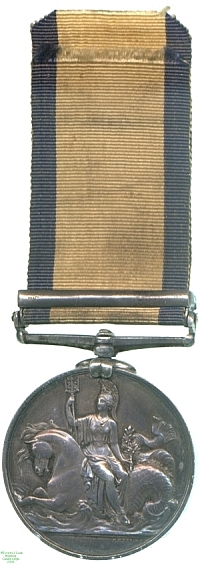
Obverse, a bust of Queen Victoria

Reverse, Britannia with a trident seated sideways on a seahorse

Obverse, a bust of Queen Victoria |

Reverse, Britannia with a trident seated sideways on a seahorse |
Just as in 1848 the extensive land campaigns of the Napoleonic Wars and the other conflicts of the pre-Victorian era were recognised by the issue of the Military General Service Medal, those serving in the Navy at the time were recognised with the Naval General Service Medal. As with the Army equivalent and the East India Company's related award, many of the battles for which the medal was awarded had been fought so long ago that few if any claimants survived.
In addition, bars were awarded for many actions whose significance and size were, despite the heroism displayed by those involved, relatively minor. The result was that many of the bars were issued in tiny numbers, with some combinations all but unique, and the medals command a very high price among collectors because of this rarity and individuality. This in turn, along with the manufacture in most cases of more bars than were eventually issued, has led to the `improvement' of many common awards where recipients' names are shared with those present at `rarer' battles. The medal also shares with the Military General Service and Army of India Medals the oddity that Queen Victoria, whose portrait they bear, was not the ruler under whom the battles for which it was awarded were fought.
In 1806, the French naval squadron that had been operating in the Far East and had mauled HMS Centurion two years previously returned homeward, reduced to the ship of the line Marengo and the frigate Belle Poule, under Arrière-Admiral Charles-Alexandre Linois. Unfortunately for them they were encountered by HMSS Foudroyante, Amazon and London not far off Brest, and while Amazon forced the surrender of the Belle Poule, London was able to capture the Marengo. Separate bars were awarded to each vessel's crew (27 and 28 awards respectively only).
This medal was awarded to Clerk William K. Cowley, of HMS London. His service aboard has been verified. Lester Watson purchased the medal from the dealer Gifford at some point before 1928. It had previously been sold at Debenham's in June 1899.